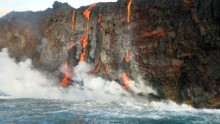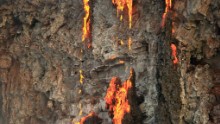Sizzling lava hits the water -- at last
Lava from Hawaii's Kilauea Volcano reaches Pacific Ocean
 Photos:The lava flow is about 66 feet wide at the point where it tumbles off a cliff into the water.Hide Caption5 of 9
Photos:The lava flow is about 66 feet wide at the point where it tumbles off a cliff into the water.Hide Caption5 of 9 Photos:Tour boat captain Kanoa Jones says sunrise is the best time to photograph the lava because the sun is at your back.Hide Caption6 of 9
Photos:Tour boat captain Kanoa Jones says sunrise is the best time to photograph the lava because the sun is at your back.Hide Caption6 of 9 Photos:Kilauea has been active since 1983. In 2014, a lava flow led to the evacuation of the village of Pahoa.Hide Caption7 of 9
Photos:Kilauea has been active since 1983. In 2014, a lava flow led to the evacuation of the village of Pahoa.Hide Caption7 of 9 Photos:The U.S. Geological Survey says this lava flow poses no immediate threat to nearby communities.Hide Caption8 of 9
Photos:The U.S. Geological Survey says this lava flow poses no immediate threat to nearby communities.Hide Caption8 of 9 Photos:The USGS warns that it can be dangerous and even deadly to get too close to the lava flow.Hide Caption9 of 9
Photos:The USGS warns that it can be dangerous and even deadly to get too close to the lava flow.Hide Caption9 of 9 Photos:Photographer David Ford got a closeup look at the lava flowing from Kilauea Volcano during a sunrise boat tour.Hide Caption1 of 9
Photos:Photographer David Ford got a closeup look at the lava flowing from Kilauea Volcano during a sunrise boat tour.Hide Caption1 of 9 Photos:Ford says they sailed about 200 feet away from the lava, off the coast of Puna in Hawaii Volcanoes National Park. He says he could smell sulfur and hear a sizzle as lava fell into the Pacific Ocean.Hide Caption2 of 9
Photos:Ford says they sailed about 200 feet away from the lava, off the coast of Puna in Hawaii Volcanoes National Park. He says he could smell sulfur and hear a sizzle as lava fell into the Pacific Ocean.Hide Caption2 of 9 Photos:Lava has been flowing out of the volcano since May 25.Hide Caption3 of 9
Photos:Lava has been flowing out of the volcano since May 25.Hide Caption3 of 9 Photos:The U.S. Geological Survey says the lava flowed 6.5 miles before reaching the Pacific.Hide Caption4 of 9
Photos:The U.S. Geological Survey says the lava flowed 6.5 miles before reaching the Pacific.Hide Caption4 of 9 Photos:The lava flow is about 66 feet wide at the point where it tumbles off a cliff into the water.Hide Caption5 of 9
Photos:The lava flow is about 66 feet wide at the point where it tumbles off a cliff into the water.Hide Caption5 of 9 Photos:Tour boat captain Kanoa Jones says sunrise is the best time to photograph the lava because the sun is at your back.Hide Caption6 of 9
Photos:Tour boat captain Kanoa Jones says sunrise is the best time to photograph the lava because the sun is at your back.Hide Caption6 of 9 Photos:Kilauea has been active since 1983. In 2014, a lava flow led to the evacuation of the village of Pahoa.Hide Caption7 of 9
Photos:Kilauea has been active since 1983. In 2014, a lava flow led to the evacuation of the village of Pahoa.Hide Caption7 of 9 Photos:The U.S. Geological Survey says this lava flow poses no immediate threat to nearby communities.Hide Caption8 of 9
Photos:The U.S. Geological Survey says this lava flow poses no immediate threat to nearby communities.Hide Caption8 of 9 Photos:The USGS warns that it can be dangerous and even deadly to get too close to the lava flow.Hide Caption9 of 9
Photos:The USGS warns that it can be dangerous and even deadly to get too close to the lava flow.Hide Caption9 of 9 Photos:Photographer David Ford got a closeup look at the lava flowing from Kilauea Volcano during a sunrise boat tour.Hide Caption1 of 9
Photos:Photographer David Ford got a closeup look at the lava flowing from Kilauea Volcano during a sunrise boat tour.Hide Caption1 of 9 Photos:Ford says they sailed about 200 feet away from the lava, off the coast of Puna in Hawaii Volcanoes National Park. He says he could smell sulfur and hear a sizzle as lava fell into the Pacific Ocean.Hide Caption2 of 9
Photos:Ford says they sailed about 200 feet away from the lava, off the coast of Puna in Hawaii Volcanoes National Park. He says he could smell sulfur and hear a sizzle as lava fell into the Pacific Ocean.Hide Caption2 of 9 Photos:Lava has been flowing out of the volcano since May 25.Hide Caption3 of 9
Photos:Lava has been flowing out of the volcano since May 25.Hide Caption3 of 9 Photos:The U.S. Geological Survey says the lava flowed 6.5 miles before reaching the Pacific.Hide Caption4 of 9
Photos:The U.S. Geological Survey says the lava flowed 6.5 miles before reaching the Pacific.Hide Caption4 of 9 Photos:The lava flow is about 66 feet wide at the point where it tumbles off a cliff into the water.Hide Caption5 of 9
Photos:The lava flow is about 66 feet wide at the point where it tumbles off a cliff into the water.Hide Caption5 of 9








Story highlights
- Lava from Kilauea Volcano is flowing into the ocean
- Flow poses no immediate threat to nearby communities
(CNN)The Big Island of Hawaii is getting a little bigger as lava from the Kilauea Volcano flows into the Pacific Ocean.The 6.5 mile-long lava flow has been dribbling down the south flank of Kilauea since May, according to the U.S. Geological Survey Hawaiian Volcano Observatory. It reached the ocean on Tuesday morning.The USGS said the flow is about 20 meters (66 feet) wide where it spills over the cliff into the sea.The red-hot lava creates huge plumes of steam as it hits the water and begins cooling into rock, delighting locals and eager tourists.Kilauea, one of the world's most active volcanoes, is part of Hawaii Volcanoes National Park.Kanoa Jones has a full-time job as a mechanic and welder, but has taken a leave of absence to run lava boat tours.He's gotten a permit for his company and has been captaining his brother's boat, while he puts the finishing touches on his own vessel."There's been people calling for a month now, trying to get in the boat," Jones said. He plans to start doing sunrise and sunset tours on Monday.Most days, Jones said, you could probably sail right up to the lava, but he keeps a safe distance."Sometimes, if the lava's flowing heavy when it hits the water it could explode, but usually it's really mellow," he said adding that you can still feel the heat on the boat.David Ford rode near the lava flow in a different boat and said he could smell sulfur and hear a sizzle when the lava hit the water."I have never seen an ocean entry from the ocean, and it was really cool to see from that angle, lower than a helicopter, and no cliff in the way as would happen if viewing from land," Ford said.You can get closer to the flow if you're willing to endure a tough hike.The USGS warns that getting too close can be extremely dangerous, and even deadly. The agency has released a pamphlet listing the risks from collapsing ledges, acid fumes, steam vents that can toss rocks and jets of hot lava -- not to mention the risk of heat stroke, sprained ankles and other injuries on the hike.Kilauea has been active since 1983, but this is the first time in three years that lava has reached the ocean.In June 2014, lava threatened the village of Pahoa, forcing residents to evacuate and destroying at least one home.There is no immediate threat to nearby communities.
To the best of my ability I write about my experience of the Universe Past, Present and Future
Top 10 Posts This Month
- Rosamund Pike: Star of New Amazon Prime Series "Wheel of Time"
- Belize Barrier Reef coral reef system
- SNAP rulings ease shutdown pressure as Thune rebuffs Trump call to end filibuster
- Flame (the Giant Pacific Octopus) whose species began here on earth before they were taken to another planet by humans in our near future
- Learning to live with Furosemide in relation to Edema
- Earthquake Scientists Say It's Time to Start Paying Attention to Antarctica
- I put "Blue Sphere" into the search engine for my site and this is what came up.
- John Travolta Finally Breaks His Silence
- Siege of Yorktown 1781
- Nine dead, dozens injured in crowd surge at Hindu temple in southern India
Subscribe to:
Post Comments (Atom)


















No comments:
Post a Comment